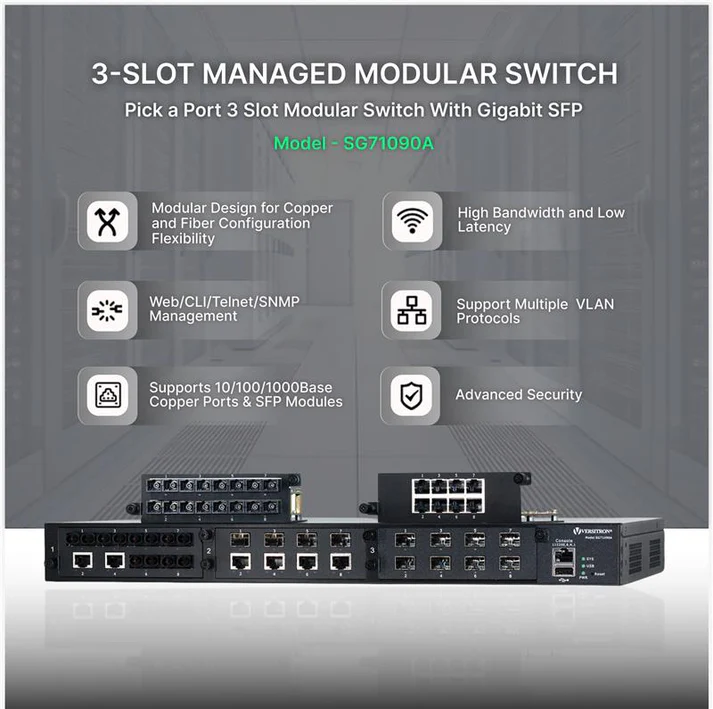What Are Modular Fiber Optic Switches?
A modular fiber optic switch is a network switch designed with a modular architecture, allowing users to customize the switch configuration based on their specific requirements. Unlike fixed-configuration switches, modular switches provide flexibility by enabling the addition or replacement of components such as line cards, power supplies, and management modules.
These switches utilize fiber optic technology for data transmission, offering high-speed connectivity with minimal signal loss. They are widely used in environments where data integrity, speed, and network reliability are critical.
Key Features of Modular Fiber Optic Switches
1. Scalability
- Modular design allows for easy expansion by adding new modules or upgrading existing ones.
- Supports increasing network demands without requiring a complete hardware replacement.
2. High-Speed Data Transmission
- Uses fiber optic technology to enable data transfer rates ranging from 1 Gbps to 400 Gbps and beyond.
- Reduces latency and ensures minimal signal loss.
3. Flexible Port Configurations
- Supports multiple interface types, including SFP, SFP+, QSFP, and QSFP28 transceivers.
- Enables customized port density based on network requirements.

4. Redundancy and Reliability
- Hot-swappable modules and power supplies ensure continuous network operation.
- Redundant power and cooling systems minimize downtime.
7. Remote Management and Monitoring
- Features SNMP, CLI, web-based interfaces, and software-defined networking (SDN) compatibility.
- Simplifies network monitoring and troubleshooting.
5. Advanced Traffic Management
- Supports VLANs, Quality of Service (QoS), and traffic prioritization.
- Enables efficient data flow control in high-demand applications.
6. Network Security Features
- Integrated security protocols such as Access Control Lists (ACLs), encryption, and authentication mechanisms.
- Protects data integrity and prevents unauthorized access.
Benefits of Using Modular Fiber Optic Switches
1. Cost-Effectiveness
While modular switches may have a higher initial investment than fixed-configuration switches, they provide long-term cost savings by allowing gradual upgrades and minimizing the need for complete replacements.
2. Future-Proofing
Businesses can adapt to evolving network requirements by adding higher-capacity modules, ensuring the infrastructure remains relevant as technology advances.
3. Improved Network Performance
With high-speed fiber optic connectivity and efficient traffic management, modular switches optimize network performance, reducing bottlenecks and improving data flow.

4. Enhanced Redundancy and Fault Tolerance
Modular architecture supports failover mechanisms, minimizing network disruptions due to hardware failures.
5. Space Efficiency
By integrating multiple networking functions into a single chassis, modular switches reduce the need for additional hardware, optimizing rack space utilization.
Applications of Modular Fiber Optic Switches
Enterprise Networking
Research Institutions
Data Centers
ISPs
Telecommunications
Industrial Applications
Smart City Applications
Cloud Computing

Factors to Consider When Choosing a Modular Fiber Optic Switch
- Network Requirements – Assess current and future network traffic demands to select the appropriate switch capacity and scalability.
- Port Density and Speed – Choose the right number of ports and speed capabilities based on network topology and bandwidth needs.
- Redundancy and Failover Capabilities – Ensure the switch includes redundant power supplies, hot-swappable modules, and failover mechanisms for uninterrupted operation.
- Compatibility and Interoperability – Verify compatibility with existing networking equipment, fiber transceivers, and software-defined networking solutions.
- Security Features – Look for advanced security protocols, encryption, and access controls to safeguard network data.
- Management and Monitoring Options – Consider switches with remote management features such as SNMP, CLI, and web-based dashboards for simplified network administration.
- Budget and Total Cost of Ownership – Evaluate the initial investment, upgrade costs, and long-term maintenance expenses to determine the best value.
